This post and photos may contain Amazon or other affiliate links. If you purchase something through any link, I may receive a small commission at no extra charge to you. Any supplies used may be given to me free of charge, however, all projects and opinions are my own.
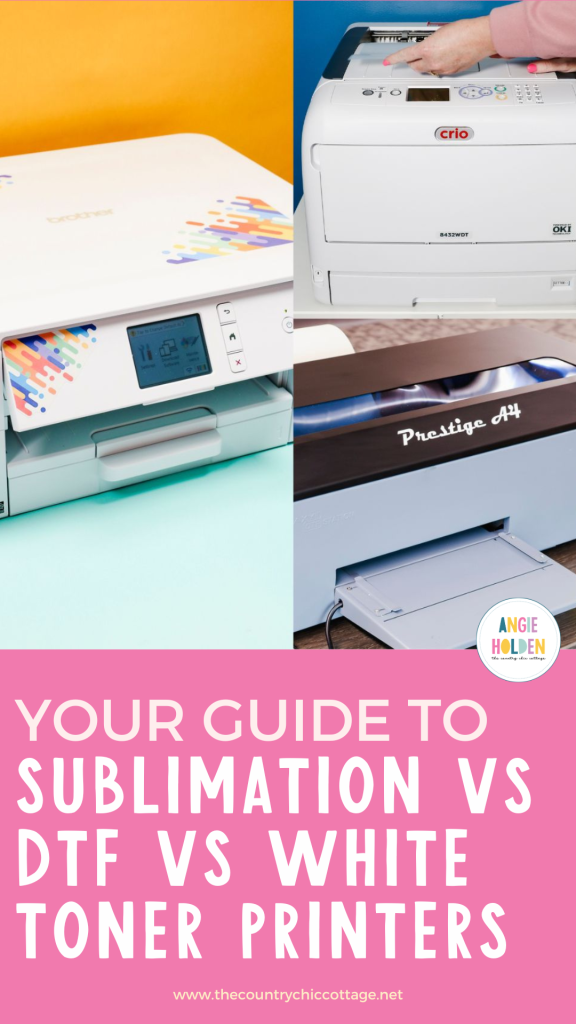
Are you trying to decide which craft printer is best for your crafting needs? I’ve been talking about a lot of printers recently, sublimation, DTF, and of course sublimation. Today I will compare sublimation vs DTF vs White Toner printers to show you what each can do.
All of these printers have a place in crafting, my goal is to help you figure out which of these printers is right for you and your craft needs.
You can learn more about each of these printers here on my site. I have tutorials on sublimation, DTF, and white toner printers to help you make projects for gifts or your small business.
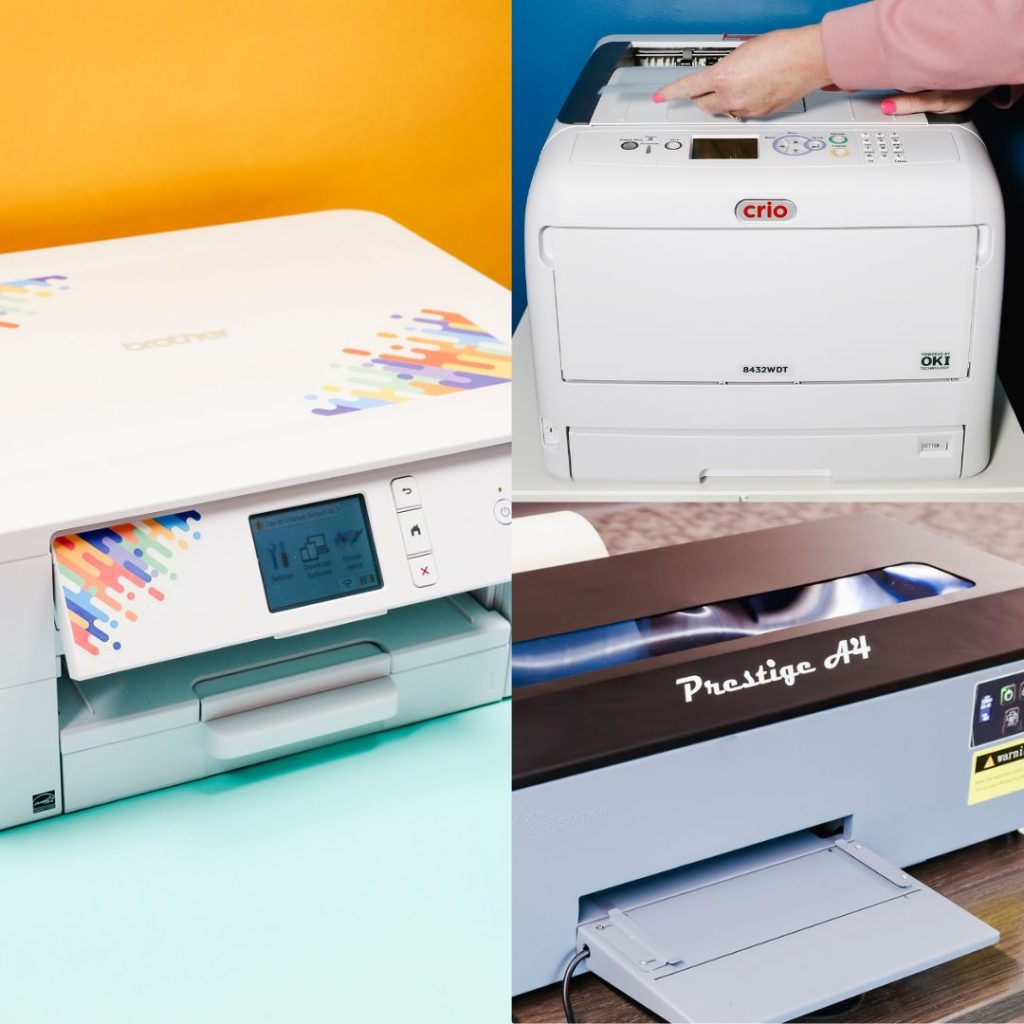
You can watch me share about each of these printers by pressing play on the video below.
Table of Contents
What Printer is Best?
Which printer is best is going to be dependent on the type of crafter you are and what your needs are. I’m going to give you a brief overview of each printing method, the pros and cons of each printer, and how they compare with one another.
Let’s look at each of the different printing methods.
Sublimation Printing
A sublimation printer prints sublimation ink onto sublimation paper and then you use heat to transfer that ink onto light-colored blanks.
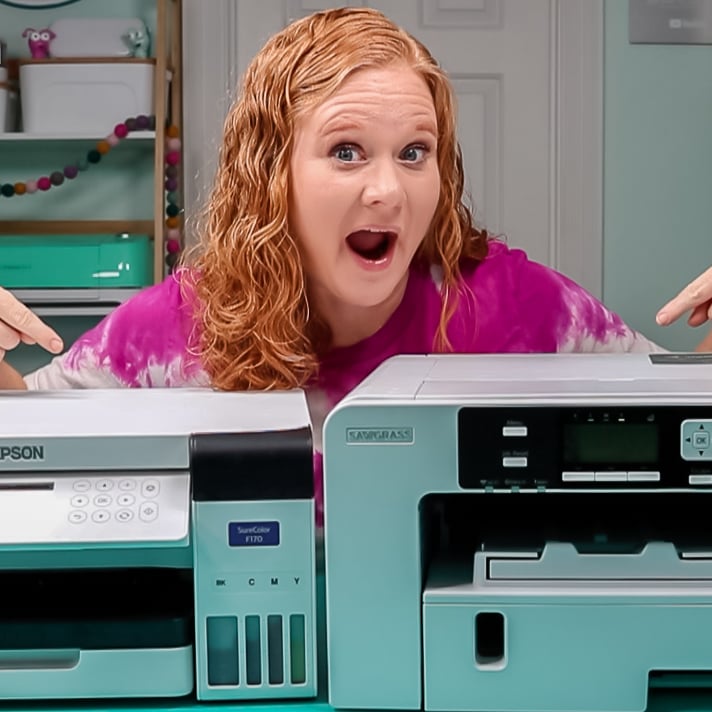
Sublimation blanks need to be light-colored or white and they need to have some type of polyester content. If you’re using fabric, it should be at least 65% polyester. Other blanks need to have a poly coating applied.
You also need high heat and consistent pressure.
Sublimation is a chemical reaction and it takes sublimation ink, poly-coating, and heat to make the chemical reaction occur. Sublimation prints can be applied to a variety of different surfaces from clothing to slate.
DTF Printing
A true DTF printer prints on clear film, either on sheets or rolls. DTF printers print five colors, the typical black, cyan, yellow, and magenta, and it also prints white.
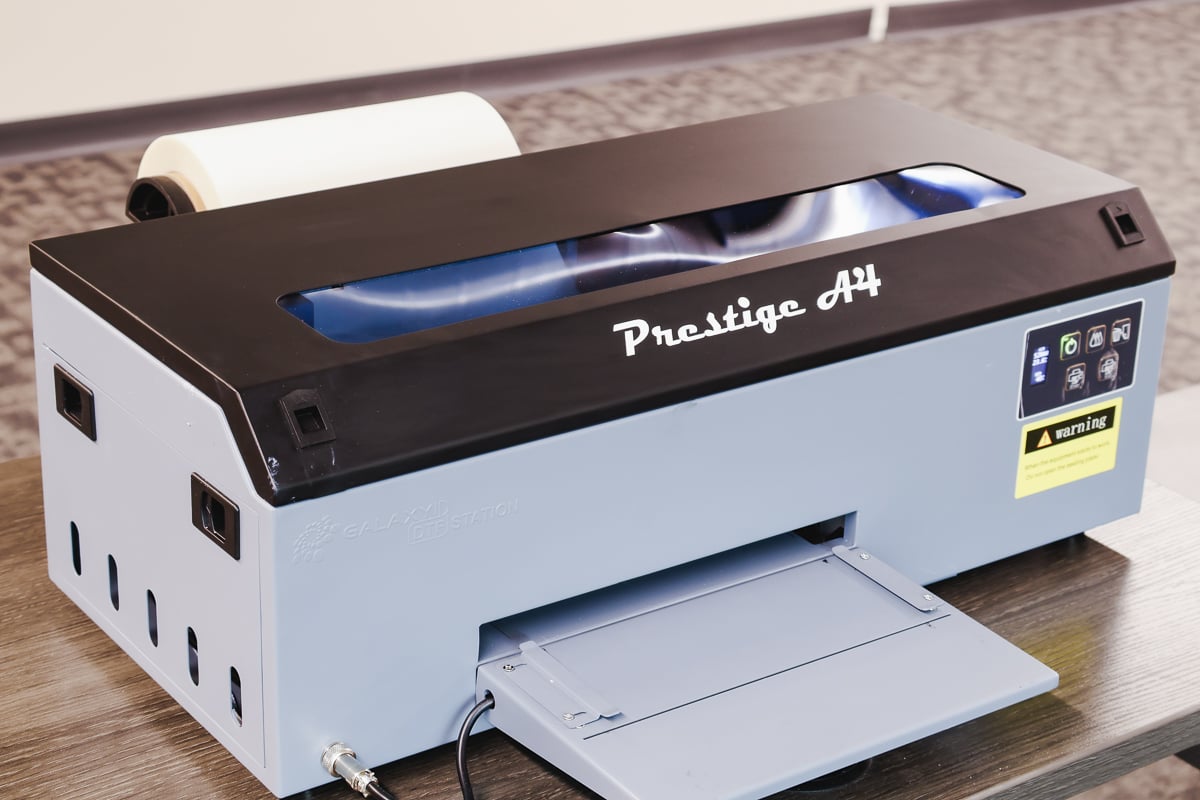
Because it prints white you will run your design through RIP software and that will translate the print from a normal CYMK print to a design that will print the white ink also.
A DTF printer is only part of the process. After you print there are additional steps required before you can apply the design to a garment. You need to apply a powder adhesive to the ink and then cure the powder. When those steps are complete, you can apply the print to any type of fabric using a heat press.
DTF prints are made specifically for fabric. They are not permanent on other surfaces.
White Toner Printing
White Toner printers do not use ink, they print with a powder-like substance (toner) that comes in cartridges that you put in the printer.
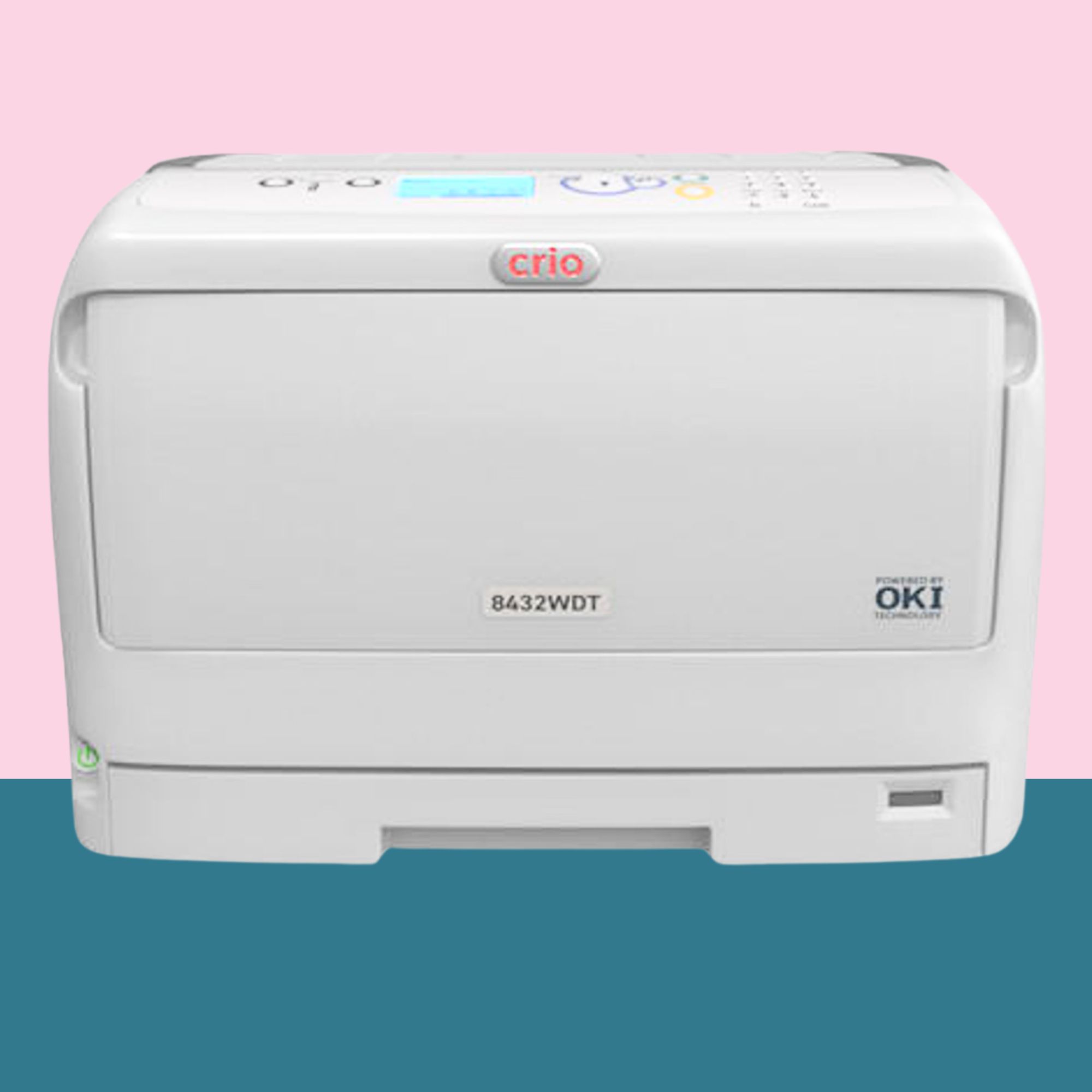
You can apply the prints to a variety of different blanks and depending on the blank you’re using you’ll choose a certain type of paper to print onto.
White toner printers do print white, as the name suggests, and depending on the printer you have it may or may not have a black toner. If your printer doesn’t have a black toner, it will mix the other colors to create black.
Just like DTF printing, you will run the design through RIP software and it will translate the design to print with the colors your printer has.
White toner prints come out of the printer completely dry but they are not ready to press yet. With most papers, you will need to marry the print to some type of adhesive using a heat press. When that process is complete it’s ready to press.
White toner prints can be used on clothing and various other surfaces, including mylar balloons.
Pros and Cons of Sublimation vs DTF vs White Toner Printers
I have in-depth tutorials on each of these different printers. You can learn more about sublimation printing, DTF printing, and white toner printing by clicking each of the links.
Now that we’ve done an overview of each printer let’s look at the pros and cons of each one.
Sublimation Printer Pros
- A sublimation printer is the least expensive of the three printer options we’re talking about today. You can get a sublimation printer in a wide variety of price ranges. A converted Epson EcoTank printer is the lowest price point. The Sawgrass printer is on the higher end. I have also reviewed the Brother sublimation printer and the Epson F170.
- Overall, sublimation printers are way less expensive than DTF and white toner printers which means it’s less of an investment to get started.
- Sublimation printers like the Sawgrass and Brother are more expensive than converting an EcoTank but they are very easy to set up and they do their own maintenance. This means if you go out of town, as long as they’re plugged in they will do maintenance and you shouldn’t have to worry about clogs.
- Sublimation ink bonds permanently to the poly fibers. There is no adhesive, the ink becomes part of the blank and in most cases, the design will last as long as the blank itself.
- Overall, sublimation is a very easy process that is not expensive to get into and creates stunning and amazing results.
Sublimation Printer Cons
- If you choose to convert an EcoTank printer, you may find it requires more manual maintenance or color correction which can be frustrating. You will need to print very regularly to prevent clogs in the ink lines.
- Sublimation ink is translucent which is why you need white or light-colored blanks. You also need that poly-coating so the blanks can be limited.
- In order to use cotton fabrics or dark colors, you will need a hack. Any sublimation hack will degrade the longevity of the sublimation itself.
- Sublimation is amazing and popular, and I don’t see it going anywhere anytime soon but it can be frustrating which may be why DTF and white toner printing are becoming more popular.
DTF Printer Pros
- The DTF printer pro is definitely the pressing portion. The pressing is the easiest part of the entire process. Pressing DTF prints is so easy. I’ve tested the pressing process with all of the different heat presses and it does great every single time.
- DTF prints feel great on shirts. It does sit on top of the fabric but it’s very thin and feels stuck on very well.
- The wearability is amazing and it stretches well with the fabric.
DTF Printer Cons
- Getting started with DTF printing is very expensive. A DTF printer bundle is going to run you $3,000 to $4,000 and the printer itself is very high maintenance.
- DTF printers require maintenance every time you use them. You need to do maintenance before you start it up and when you shut it down even if you’re only printing one page. The maintenance can get very frustrating.
- I also have safety concerns with DTF printing as it is currently done. The print itself is rather safe but the powder is where the safety concerns come in. I hope in the future there will be more safety regulations around the powder aspect of DTF printing.
- Most people do the adhesive powder in something like a tub. The DTF powder sticks to the ink while it’s wet on the film. The powder is a very fine microplastic powder and it gets everywhere. If you’re doing the printing and powdering process at home I recommend you follow all the safety regulations. Wear a mask, wear gloves, wear something to cover your clothing like an apron, and wear protective goggles.
- I don’t recommend any of the DTF hacks out there, I don’t think they’re safe. Make sure you use the oven for the curing process because the oven comes with an air filter that will filter out all the fumes.
White Toner Printer Pros
- The main benefit of the white toner printer to me is that the printer has zero maintenance. I can print today, unplug it, plug it back in in three months, and print again and it’ll print perfectly. I don’t have to perform any maintenance when I start it up or shut it down. This is important to me because I personally don’t print enough to make all that maintenance worth it.
- The printer setup and use of the printer is very easy, right out of the box.
- White toner printing has been around for a while so there are a lot of different papers you can print on to get different effects. There is also a lot of information on how to do different projects. Because people have been using white toner for years there are tutorials for pretty much every project you can imagine which makes the process easier.
- The print itself has a great feel on garments. After running the white toner print through the laundry a few times it looked the same, amazing and vibrant, and actually felt better.
White Toner Printer Cons
- The cost of a white toner printer is similar to the DTF printing setup but can be more expensive depending on the brand you purchase.
- The pressing process for white toner printing is more involved than both sublimation and DTF printing.
- You will need a full-size heat press that can apply heavy even pressure to get the best results. When you do the pressing portion correctly, you will get more consistent wearability results.
- The pressing portion has a learning curve. You have to marry the print to the adhesive and you have to make sure you’re using the right paper and adhesive for the blank you’re pressing to.
- As you’re learning white toner printing, I would suggest you buy multiple of each blank because you may ruin a blank or two as you get your pressing methods down.
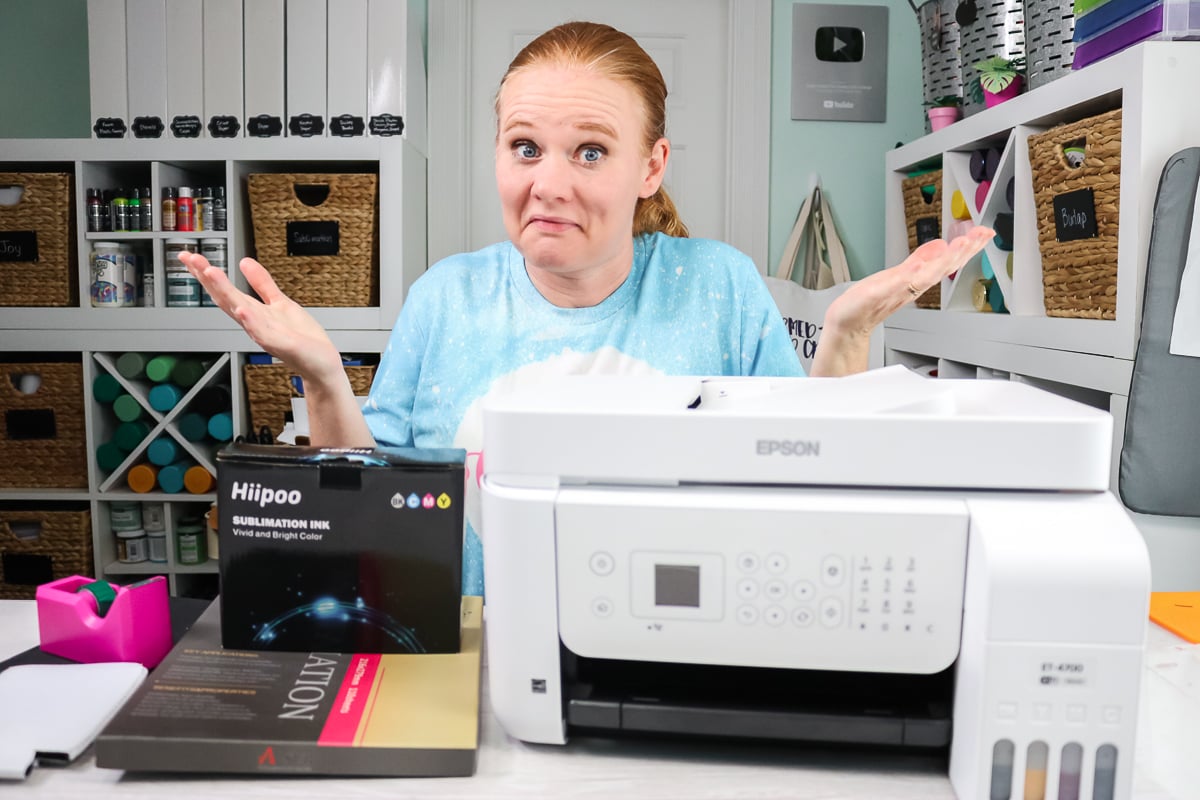
Which Printer is Right for You?
Now that we’ve looked at the different printing methods, how do you know which printer is right for you? Sublimation vs DTF vs White Toner Printers, answering these questions may help.
First, I would think about the projects you’re going to make. Can you make them with a sublimation blank or light-colored polyester garment? If you can, a sublimation printer is probably right for you.
Sublimation printing is a permanent method of application and it’s the least expensive printing method I’ve shown you today.
DTF and White Toner printing both have pros and cons and which printer is right for you will depend on how much you have to invest.
I would also consider the safety concerns with DTF printing and if you have a space large enough for the whole process.
If you’re considering a white toner printer, do you have the right type of heat press that can apply heavy pressure? If you don’t, that will be an additional investment you need to consider.
Are You Running a Handmade Business?
Another question that might help you decide which printing process is right for you is do you have a small handmade business?
White toner and DTF printers are expensive. When deciding if the cost is worth it, you can consider selling prints. While you may not have enough orders for finished products to justify the cost, selling prints may help you make up the difference.

Craft your future by turning your passion into a paycheck! With more than 25 years experience and a DIY community of more than 1.5 million, Angie Holden and Cori George share handmade business strategies, craft business insights, and inspirational stories. Every other Monday, you’ll learn from experts how to use your crafts to financially support a creative life.
Click here to sign up so you don’t miss future episodes of Crafting for Profit Live!
Where to Order Your Printer
Now that you have decided which printer type if for you, use the links below to start your ordering process!
If your current business budget doesn’t include a DTF or White Toner printer, you may find that ordering prints from a place like Heat Transfer Warehouse will allow you to expand the products you offer without the upfront cost of a new printer.
I hope I’ve answered your questions about sublimation vs DTF vs white toner printers. If you aren’t sure which printer is right for you, drop down to the comments and tell me what type of projects you want to make and what type of investment you are willing to make, and hopefully I’ll be able to help you decide on the right printer for your needs.

